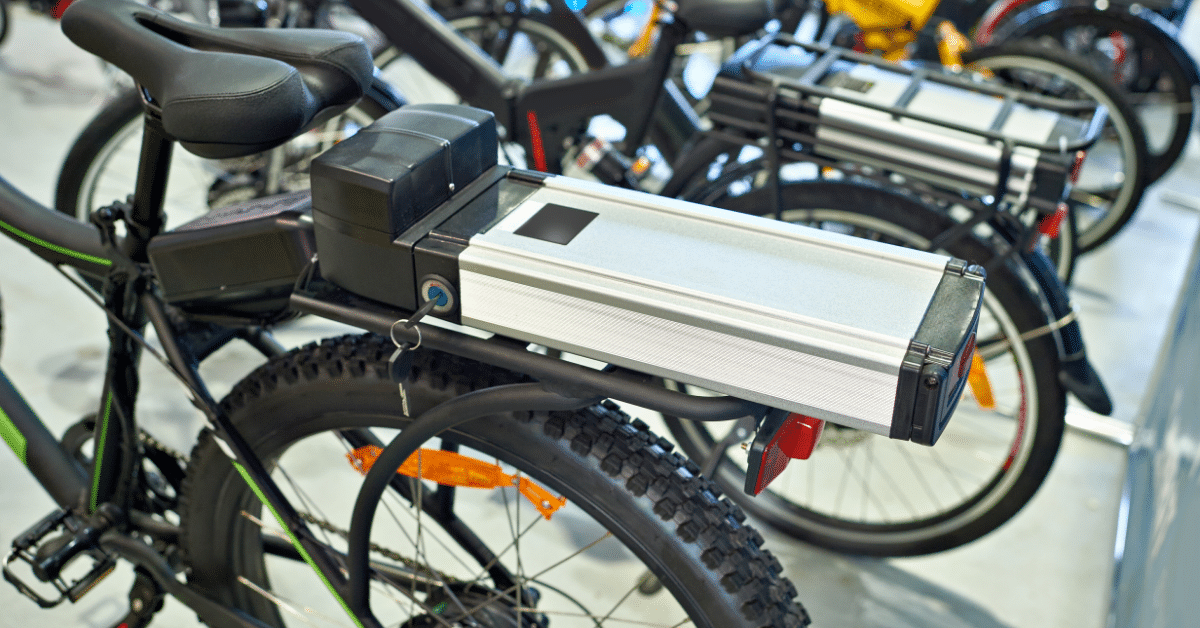Safe Lithium-Ion Battery Storage and Charging Procedures for the eBike Shop
Guidelines provided by Human Powered Solutions. Get a PDF copy of this guide.
Preface
Lithium-ion batteries are everywhere in modern life. Our cell phones, tablets, laptop computers, digital cameras…. too many products to list, are all powered by these batteries. Lithium-ion battery chemistry is extremely important in these applications given its high energy density. In other words, lithium-ion batteries store an incredible amount of energy in a small, lightweight package. This enables hours of dependable service between charges in whatever application these batteries are used.
With the development of high-power lithium-ion batteries, we now have the breakthrough in electrical energy storage and delivery technologies that makes electric vehicles practical for transportation needs. Heretofore, we have not had the ability to store enough electrical energy in a lightweight battery pack that also has the ability to deliver that energy to the vehicle fast enough to accelerate heavy loads to useful speeds.
But this utility comes with requirements for safe design, construction, use, storage and maintenance. High energy storage always carries the danger that if the energy is released in an uncontrolled fashion, a potentially catastrophic situation can develop. Just as tossing a lit match into a bucket of gasoline will generate a very unpleasant result, so can issues with the production and use of lithium-ion batteries.
Technology has enabled the safe use and storage of gasoline. We typically park our cars in our garages in close proximity to our living spaces without a second thought. Scientists and the battery industry are working hard to allow us the same sense of security and comfort with respect to the adaptation of high energy lithium-ion batteries.
However, we are not there yet. While we have come a long way in terms of developing safe, stable lithium-ion battery cells and well-engineered, robust battery packs harnessing the power of those cells, potentially catastrophic failures do still occur.
Electric bicycles (eBikes) have become the fastest growing segment of the bicycle business. EBikes are rapidly becoming a viable element of our transportation infrastructure, for reasons too numerous to list here. This development is changing the face of conventional bicycle retailing. Forward looking bike shops have embraced the sale and service of eBikes as an important and profitable aspect of their business.
But just as gas stations take special safety precautions to minimize the chance of an uncontrolled release of energy (fires), so too must bike shops take safety precautions with the maintenance, storage and delivery of the lithium-ion battery packs used to power the eBikes that they sell and service.
These guidelines are offered as recommendations for your facilities and your policies and procedures associated with eBike battery packs. While knowing that the chances of a lithium-ion battery fire are minuscule, the ramifications of a battery fire are so significant that these relatively simple steps are more than justified.
Please give careful consideration to these guidelines. If you have questions or concerns, we at HumanPowered Solutions are available to assist with their implementation.
Thank you.
Set up your battery charging and storage area:
- Procure a fire-resistant storage cabinet (these can be purchased from com, or industrial supply companies such as Granger, McMaster-Carr, etc.). Most fire-resistant cabinets are equipped with flame arresting vents. If practical, vent the cabinet to the outside.
- Source a cabinet of sufficient size to hold as many eBike batteries that you anticipate having from new eBike inventory and customer e-bikes in the shop for repair.
- The cabinet should be located in an area free from trash, cardboard, paint or any other flammable materials, or dampness and moisture.
- Store ALL e-bike batteries in the fire-resistant cabinet until needed for delivery to a customer.
- Set up an e-bike battery charging cart near-by the fire-resistant cabinet. The cart should be of metal wire construction and be fitted with wheels for easy movement. (These are also available from industrial supply companies, as well as Costco, com, etc.)
- Zip-tie power strips to the wire cart so that chargers can be easily and neatly connected to the power strips. Power strips should have integrated ON/OFF switches.
- If possible, store the charging cart near a door with access to the outside. A garage door to the outside is ideal.
- The charging cart should be located in an area free from trash, cardboard, paint or any other flammable materials, or dampness and moisture.
- Mount at least one Class A, B and C fire extinguisher within easy reach of the battery charging station.
- Install a smoke detector on the ceiling, or high on a wall in close proximity to the fire resistant storage cabinet and charging station.
- As an extra precaution, position a 32-gallon (or larger) plastic trash can (with a lid) adjacent to the charging cart. Fill the trash can 3/4ths with clean water. Fix the lid to the trash can.
Lithium-Ion battery pack storage procedures:
- Store ALL of the lithium-ion eBike battery packs in your shop in the fire-resistant cabinet at all times, except when packs are being charged prior to delivery to customers.
- When new eBikes are received, store the batteries in the fire-resistant cabinet in their original cartons WITHOUT pre-charging. Only charge a battery pack just prior to delivery.
- DO NOT CHARGE EBIKE BATTERY PACKS IN THE STORAGE CABINET. Only charge battery packs on the charging cart.
- If your store has rental eBikes or demonstrator eBikes on-hand, charge and store the battery packs from those rental and/or demo eBikes according to these procedures. However, it is OK to leave the battery packs installed on rental and/or demo eBikes during normal store hours so that the eBikes are ready for rental and/or demo usage without having to retrieve a battery pack from storage. However, the packs must be removed and stored in the fire-resistant cabinet overnight. DO NOT RECHARGE RENTAL/DEMO EBIKE BATTERY PACKS OVERNIGHT WHILE THE STORE IS CLOSED AND THE CHARGING CART UNATTENDED.
- When eBikes are brought in for service, remove the battery pack from the customer’s eBike and store it in the cabinet until it is needed for testing, or to return to the customer after service.
- If a customer brings in a damaged battery pack, store it OUTSIDE away from any flammable materials. Consult your local fire department for guidance on safe disposal of a damaged battery pack. DO NOT STORE DAMAGED BATTERY PACKS IN THE FIRE- RESISTANT CABINET, OR ANYWHERE ELSE IN YOUR STORE.
Lithium-Ion battery pack charging procedures:
- Only charge eBike battery packs with the UL Approved battery charger supplied by the eBike manufacturer. Do not attempt to charge eBike battery packs with generic chargers, power supplies, or any other charging device not supplied by the eBike brand. It is often convenient to procure extra chargers from the eBike brand to set-up on the charging cart for charging that brand’s batteries so that a new, unused charger can be delivered to the customer.
- NEVER charge lithium-ion battery packs overnight or unattended. If you are charging a pack prior to delivery, and the pack is not fully charged when the store closes, remove the pack from the charging cart and store it in the fire-resistant cabinet overnight. Finish charging the pack the next morning when the store is open and staffed.
- Monitor the charging station while battery packs are being charged. When a battery charger signals that the battery is fully charged, disconnect the charger from the power strip (or turn OFF the power strip), unplug the charger from the battery pack and store the battery pack in the fire-resistant cabinet until the eBike is delivered to the customer.
- NEVER EVER open a lithium-ion battery pack. There are no user serviceable parts contained therein.
IN CASE OF EMERGENCY:
- If a battery pack starts smoking, emitting unusual noise, or showing signs of melted plastic:
- If possible to do safely, place the failing pack in the water-filled trash can; if the water-filled trash can is not available, and it is safe to do so, move the pack outside, away from any flammable materials.
- Immediately call 911 to summon the fire department.
- If the battery that is showing the symptoms listed above is on the battery charging cart, and it is not possible to safely move it to the water-filled trash can, wheel the charging cart outside, away from any flammable materials.
- If possible to do so safely, remove any additional battery packs on the charging cart to a safe distance away from the failing battery pack.
- Secure the fire-resistant cabinet by closing the door to protect the battery packs stored inside.
- If the remedial actions above are not possible to perform safely, immediately evacuate the store.
Notes on battery fires:
It is not possible to extinguish a lithium-ion battery fire. The best course of action is to mitigate the consequences of the fire.
- A lithium-ion battery fire usually occurs during charging or discharging (use) of the pack. That is why it’s critical to only charge battery packs when the charging process is monitored.
- A battery fire usually starts with a single battery cell. As the cell achieves thermal runaway, it will combust and generate dense, toxic smoke and extreme heat. The heat from the failing cell causes adjacent cells to ‘cook-off’ and the fire expands in a dangerous and uncontrolled fashion.
- The steps listed above are intended to mitigate the fire. Placing a pack with a cell in thermal runaway in the water-filled trash can tends to cool the adjacent cells and prevent or hinder propagation.
- If it is not possible to cool the pack by immersion in water, it is best to locate the pack, if it is possible to do so safely, outside away from any flammable materials.
- Damaged packs are much more susceptible to catastrophic failure (fires) due to the likelihood of internal short circuits or ruptured cells.
- We recommend at least one fire extinguisher in close proximity to the storage cabinet and charging cart in case materials near a failing battery pack catch fire. A conventional fire extinguisher will not put out a lithium-ion battery fire.
- The final remedy for a battery pack fire is to let it safely burn itself out away from any additional flammable materials.
Disclaimer: You assume all responsibility and risk for the use of the safety resources available on or through these guidelines. Human Powered Solutions, LLC (HPS) and/or the National Bicycle Dealers Association (NBDA) does not assume any liability for the materials, information and opinions provided on, or available through these guidelines. No advice or information given by HPS or the NBDA shall create any warranty. Reliance on such advice, information or the content of these guidelines is solely at your own risk, including without limitation any safety guidelines, resources or precautions related to the development or installation of battery storage and charging stations, battery storage and battery charging protocols, or emergency procedures, or any other information related to safety that may be available on or through these guidelines. HPS and NBDA disclaims any liability for injury, death or damages resulting from the use thereof.
![]()
Copyright © 2021 Human Powered Solutions All Rights Reserved.










Great guide to battery charging. Another precaution is to get a timer that will shut off the charger. This will prevent overcharging in the event that the charger’s overcharge protection is not functioning properly. Here’s what we’ve used. https://www.amazon.com/Teklectric-Curling-Straightener-Countdown-Conserve/dp/B01KKOJ42U